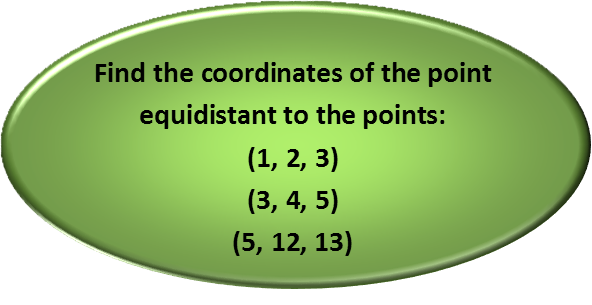Math Made Easy: Problem of the Day 104

In some ways, math in three dimensions really isn’t all that different from math in two dimensions. Many of you are familiar with finding points of equidistance (or midpoints) in two dimensions. For two points, you simply use the distance formula, and divide your result by two. But for three points, it becomes a little more complicated. BUT. The concept for finding a point of equidistance in two dimensions is identical to the way you can find it in three dimensions.
We’re still going to make use of the distance formula to do this. But instead of just dividing it by two, since that won’t work for three points, we’re going to imagine the point in the center. We’re going to label it as having the coordinates (x, y, z). Then we’re going to recognize that, if it’s equidistant from all three points, the distance from it to each of those points is the same, since that’s the definition of equidistance. So we will write the distance formula three times – once for each three points.
So let’s remind ourselves what the distance formula looks like in two dimensions.

It doesn’t look much different in three dimensions – we just add the z-coordinate to the mix.

Now we’re going to label our points A, B, and C.

And remind ourselves that those distances are all equal.

We’ll write each of the distance formulas with the coordinates for each of our points.

Then, one at a time, I’ll set one equal to another, and simplify the equation. I should come out with three equations. This is good, because I have three variables, and to solve a system of equations with three variables, I normally will need at least 3 equations. Let’s start by setting the distance from Point A to Point X (the equidistant point), and distance from Point B to Point X equal, and solving.

I recognize that, since both sides are a square root, I can square both sides and get rid of that peskiness.

I will then, one at a time, expand each binomial, and simplify. Starting with the binomials involving x.

After expanding the x binomial, I simplify by subtracting x2 from both sides (conveniently it just goes away), adding 6x to both sides, and then subtracting one from both sides. I did this all in one step to save space in the article.

Next, we can expand the y binomials.

I simplify by subtracting y2 from both sides (which also conveniently vanishes), adding 8y to both sides, and subtracting 4 from both sides, similar to what I did after expanding the x binomial.

And I do the same two steps for the z binomial.

Finally, I recognize that I can further simplify by dividing everything by four, and I arrive at a nice linear equation.

Now I do the same thing for Point A to Point X and Point C to Point X. Following the same steps, we arrive at the following:

Similarly, for Point B to Point X and Point C to Point X:

So we have the following system of equations to solve:

We can solve this by elimination – we add or subtract one equation from another with the goal of eliminating a variable – making that variable go away. I’ll pick Equation 1 and 3, because the x coefficients are the same, so if I subtract 1 from 3, the x’s go away. Once I have that, I see that I can simplify by dividing both sides of the result by 3, and I can further move the y to the right-hand side of the equation by subtracting to arrive at a value for z

Plugging that value for z back into the first equation, and simplifying, we see the y values go away, and we immediately find our x coordinate.

But here is where the interesting thing happens. Notice also, that if we plug that x coordinate back into any of the equations, AND the expression for z in terms of y, the y’s vanish, and we arrive at nonsense. That is because there is no single value of y or z that satisfies all three equations – notice their coefficients are the same in all three. Which means there is no single point equidistant to all three of these points, but rather a line, in the y-z plane, stretching off into infinity in both directions along the coordinate of x=-12. So we actually have arrived at our answer: (x, z=21-y).
Remember, the method by which we came to our solution is identical to how we would do it in 2 dimensions. There’s just no z value there. Also, and this is important - remember that equidistance and center can be two very, very different things. So don't make the mistake of thinking that a point (or line) of equidistance is the center. It might not be.
|



